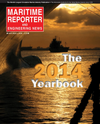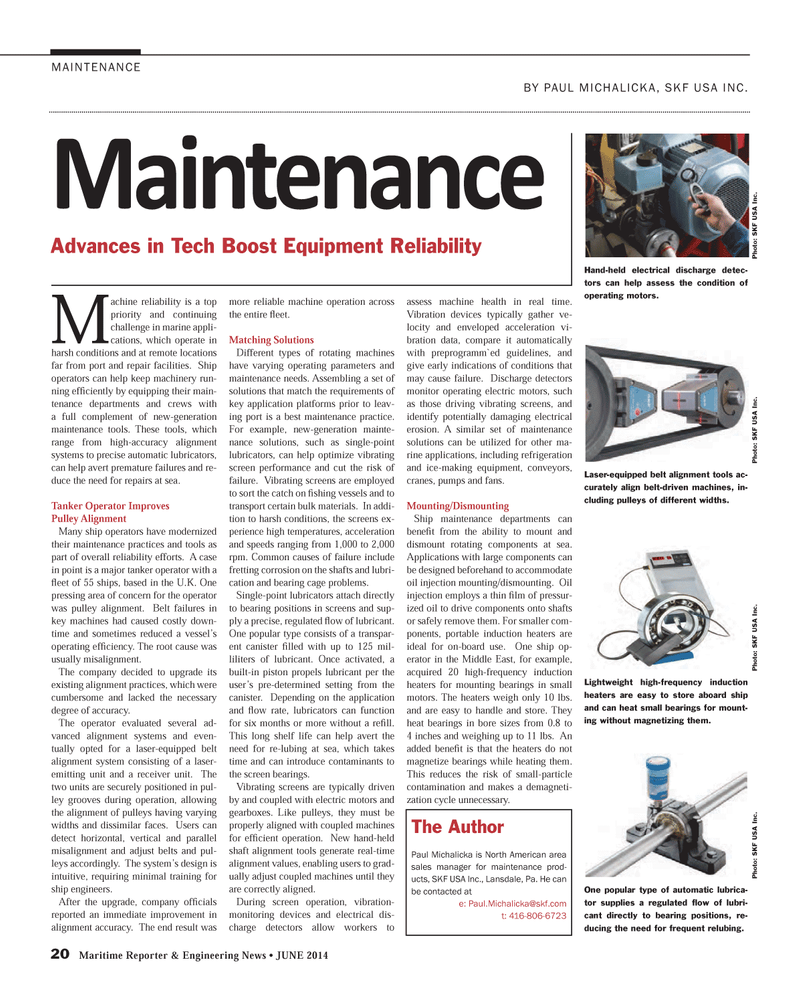
Page 20: of Maritime Reporter Magazine (June 2014)
Annual World Yearbook
Read this page in Pdf, Flash or Html5 edition of June 2014 Maritime Reporter Magazine
20 Maritime Reporter & Engineering News • JUNE 2014
MAINTENANCE
M achine reliability is a top priority and continuing challenge in marine appli- cations, which operate in harsh conditions and at remote locations far from port and repair facilities. Ship operators can help keep machinery run- ning ef? ciently by equipping their main- tenance departments and crews with a full complement of new-generation maintenance tools. These tools, which range from high-accuracy alignment systems to precise automatic lubricators, can help avert premature failures and re- duce the need for repairs at sea.
Tanker Operator Improves
Pulley Alignment
Many ship operators have modernized their maintenance practices and tools as part of overall reliability efforts. A case in point is a major tanker operator with a ? eet of 55 ships, based in the U.K. One pressing area of concern for the operator was pulley alignment. Belt failures in key machines had caused costly down- time and sometimes reduced a vessel’s operating ef? ciency. The root cause was usually misalignment.
The company decided to upgrade its existing alignment practices, which were cumbersome and lacked the necessary degree of accuracy.
The operator evaluated several ad- vanced alignment systems and even- tually opted for a laser-equipped belt alignment system consisting of a laser- emitting unit and a receiver unit. The two units are securely positioned in pul- ley grooves during operation, allowing the alignment of pulleys having varying widths and dissimilar faces. Users can detect horizontal, vertical and parallel misalignment and adjust belts and pul- leys accordingly. The system’s design is intuitive, requiring minimal training for ship engineers.
After the upgrade, company of? cials reported an immediate improvement in alignment accuracy. The end result was more reliable machine operation across the entire ? eet.
Matching Solutions
Different types of rotating machines have varying operating parameters and maintenance needs. Assembling a set of solutions that match the requirements of key application platforms prior to leav- ing port is a best maintenance practice.
For example, new-generation mainte- nance solutions, such as single-point lubricators, can help optimize vibrating screen performance and cut the risk of failure. Vibrating screens are employed to sort the catch on ? shing vessels and to transport certain bulk materials. In addi- tion to harsh conditions, the screens ex- perience high temperatures, acceleration and speeds ranging from 1,000 to 2,000 rpm. Common causes of failure include fretting corrosion on the shafts and lubri- cation and bearing cage problems.
Single-point lubricators attach directly to bearing positions in screens and sup- ply a precise, regulated ? ow of lubricant.
One popular type consists of a transpar- ent canister ? lled with up to 125 mil- liliters of lubricant. Once activated, a built-in piston propels lubricant per the user’s pre-determined setting from the canister. Depending on the application and ? ow rate, lubricators can function for six months or more without a re? ll.
This long shelf life can help avert the need for re-lubing at sea, which takes time and can introduce contaminants to the screen bearings.
Vibrating screens are typically driven by and coupled with electric motors and gearboxes. Like pulleys, they must be properly aligned with coupled machines for ef? cient operation. New hand-held shaft alignment tools generate real-time alignment values, enabling users to grad- ually adjust coupled machines until they are correctly aligned.
During screen operation, vibration- monitoring devices and electrical dis- charge detectors allow workers to assess machine health in real time.
Vibration devices typically gather ve- locity and enveloped acceleration vi- bration data, compare it automatically with preprogramm`ed guidelines, and give early indications of conditions that may cause failure. Discharge detectors monitor operating electric motors, such as those driving vibrating screens, and identify potentially damaging electrical erosion. A similar set of maintenance solutions can be utilized for other ma- rine applications, including refrigeration and ice-making equipment, conveyors, cranes, pumps and fans.
Mounting/Dismounting
Ship maintenance departments can bene?t from the ability to mount and dismount rotating components at sea.
Applications with large components can be designed beforehand to accommodate oil injection mounting/dismounting. Oil injection employs a thin ? lm of pressur- ized oil to drive components onto shafts or safely remove them. For smaller com- ponents, portable induction heaters are ideal for on-board use. One ship op- erator in the Middle East, for example, acquired 20 high-frequency induction heaters for mounting bearings in small motors. The heaters weigh only 10 lbs. and are easy to handle and store. They heat bearings in bore sizes from 0.8 to 4 inches and weighing up to 11 lbs. An added bene? t is that the heaters do not magnetize bearings while heating them.
This reduces the risk of small-particle contamination and makes a demagneti- zation cycle unnecessary.
Maintenance
BY PAUL MICHALICKA, SKF USA INC.
Advances in Tech Boost Equipment Reliability
The Author
Paul Michalicka is North American area sales manager for maintenance prod- ucts, SKF USA Inc., Lansdale, Pa. He can be contacted at e: [email protected] t: 416-806-6723
Photo: SKF USA Inc.
Hand-held electrical discharge detec- tors can help assess the condition of operating motors.
Photo: SKF USA Inc.
Laser-equipped belt alignment tools ac- curately align belt-driven machines, in- cluding pulleys of different widths.
Photo: SKF USA Inc.
One popular type of automatic lubrica- tor supplies a regulated fl ow of lubri- cant directly to bearing positions, re- ducing the need for frequent relubing.
Photo: SKF USA Inc.
Lightweight high-frequency induction heaters are easy to store aboard ship and can heat small bearings for mount- ing without magnetizing them.
MR #6 (18-25).indd 20 5/28/2014 12:12:07 PM

 19
19

 21
21
